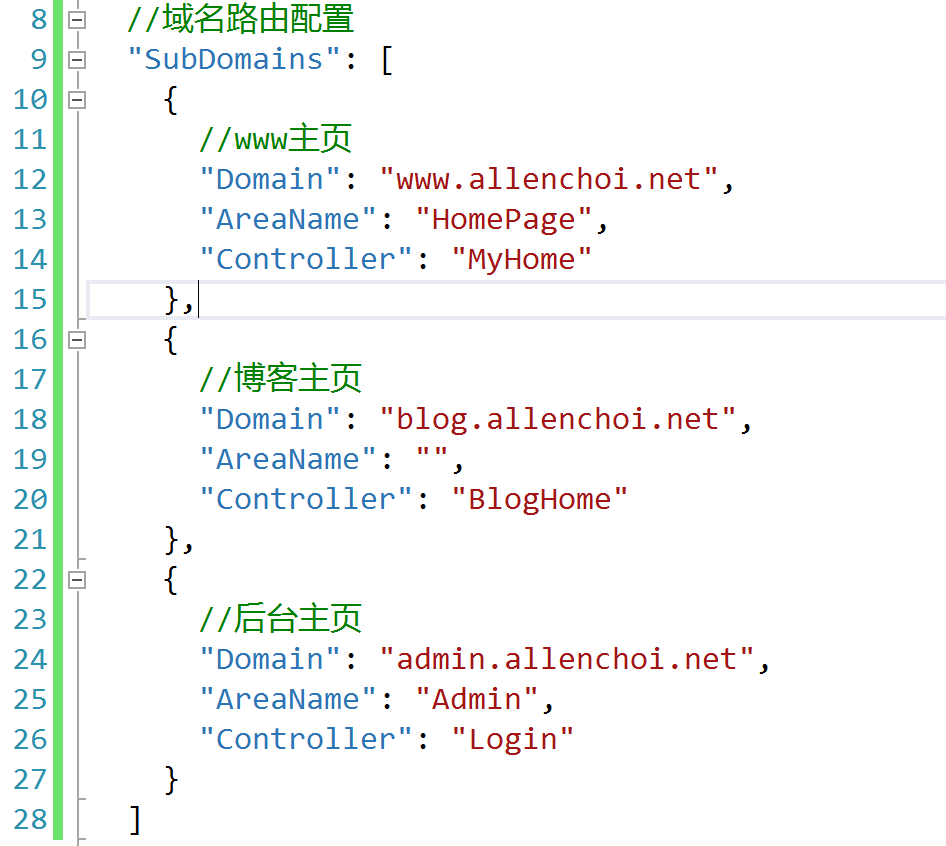在说二级域名绑定之前,先说一下.net core中的区域,关于区域这一块儿在很久之前的博客中,已经提过,详见《03-dotnet core创建区域[Areas]及后台搭建》,在这篇博客中,创建区域的时候,都是手动创建的,手动创建区域Areas文件夹,手动添加M-V-C等文件目录,由于在最早的VS2017版本中,直接右键添加区域的选项居然没了,然而在后来的VS版本更新中,这一功能又恢复了,也不知微软是出于什么考虑。区域的功能,就不用多说了,至于如何创建如何使用,也不多说,这些都是在MVC4的功能了。今天主要说一下关于二级域名如何绑定到指定的控制器。
二级域名也无需多说了吧,比如我们进入百度,我们直接输入www.baidu.com或者输入baidu.com(重定向到www.baidu.com),会直接进入百度的首页,而如果我们输入的是,news.baidu.com,则直接进入百度新闻,我们称news.baidu.com为二级域名,那输入不同的二级域名会进入不同的主页面,那这是如何实现的呢。关于二级域名绑定其实使用一些代理服务器如nginx等,都可以实现域名绑定,这些我们都不讨论,这里我们只讨论在.net core 项目中如何配置。
这里借助于一篇博客,园子中早已经有人对路由作了扩展,使其可以自定义域名绑定控制器,原文地址:《asp.net core mvc中如何把二级域名绑定到特定的控制器上》 。下面附上代码:二级域名逻辑判断,基于RouteBase扩展
- <span style="font-size:14px;">public class SubDomainRouter : RouteBase
- {
- private readonly IRouter _target;
- private readonly string _subDomain;
- public SubDomainRouter(
- IRouter target,
- string subDomain,//当前路由规则绑定的二级域名
- string routeTemplate,
- RouteValueDictionary defaults,
- RouteValueDictionary constrains,
- IInlineConstraintResolver inlineConstraintResolver)
- : base(routeTemplate,
- subDomain,
- inlineConstraintResolver,
- defaults,
- constrains,
- new RouteValueDictionary(null))
- {
- if (target == null)
- {
- throw new ArgumentNullException(nameof(target));
- }
- if (subDomain == null)
- {
- throw new ArgumentNullException(nameof(subDomain));
- }
- _subDomain = subDomain;
- _target = target;
- }
- public override Task RouteAsync(RouteContext context)
- {
- string domain = context.HttpContext.Request.Host.Host;//获取当前请求域名,然后跟_subDomain比较,如果不想等,直接忽略
- if (string.IsNullOrEmpty(domain) || string.Compare(_subDomain, domain) != 0)
- {
- return Task.CompletedTask;
- }
- //如果域名匹配,再去验证访问路径是否匹配
- return base.RouteAsync(context);
- }
- protected override Task OnRouteMatched(RouteContext context)
- {
- context.RouteData.Routers.Add(_target);
- return _target.RouteAsync(context);
- }
- protected override VirtualPathData OnVirtualPathGenerated(VirtualPathContext context)
- {
- return _target.GetVirtualPath(context);
- }
- }</span>
如何把域名绑定到指定的控制器上,代码如下:
- <span style="font-size:14px;">public static class RouteBuilderExtensions
- {
- public static IRouteBuilder MapDomainRoute(
- this IRouteBuilder routeBuilder,string domain,string area,string controller)
- {
- if(string.IsNullOrEmpty(area)||string.IsNullOrEmpty(controller))
- {
- throw new ArgumentNullException("area or controller can not be null");
- }
- var inlineConstraintResolver = routeBuilder
- .ServiceProvider
- .GetRequiredService<IInlineConstraintResolver>();
- string template = "";
- RouteValueDictionary defaults = new RouteValueDictionary();
- RouteValueDictionary constrains = new RouteValueDictionary();
- constrains.Add("area", area);
- defaults.Add("area", area);
- constrains.Add("controller", controller);
- defaults.Add("controller", string.IsNullOrEmpty(controller) ? "home" : controller);
- defaults.Add("action", "index");
- template += "{action}/{id?}";//路径规则中不再包含控制器信息,但是上面通过constrains限定了查找时所要求的控制器名称
- routeBuilder.Routes.Add(new SubDomainRouter(routeBuilder.DefaultHandler, domain, template, defaults, constrains, inlineConstraintResolver));
- return routeBuilder;
- }
- }</span>
使用方法:
- <span style="font-size:14px;">routes.MapDomainRoute("xxx.domain.com","areaname","controllername");</span>
以上代码为原博客中的代码,使用起来也很方便,只需要传值域名,区域名,控制器名,就可以实现我们想要的结果。下面我对以上代码稍作了修改,通过配置文件配置域名和控制器的绑定。新建一个关于域名、区域、控制器名的Model:
- <span style="font-size:14px;">/// 域名信息实体类
- /// <summary>
- /// 域名信息实体类
- /// </summary>
- public class SubDomain
- {
- /// 域名
- /// <summary>
- /// 域名
- /// </summary>
- public string Domain { get; set; }
- /// 区域名
- /// <summary>
- /// 区域名
- /// </summary>
- public string AreaName { get; set; }
- /// 控制器名
- /// <summary>
- /// 控制器名
- /// </summary>
- public string Controller { get; set; }
- }</span>
另外在MapDomainRoute扩展方法中,去掉了对区域的判断, 这样也可以配置非区域的控制器了,代码如下:
- <span style="font-size:14px;">public static IRouteBuilder MapDomainRoute(
- this IRouteBuilder routeBuilder, string domain, string area, string controller)
- {
- try
- {
- <span style="background-color:rgb(255,204,0);">if (string.IsNullOrEmpty(domain))
- {
- throw new ArgumentNullException("domain can not be null");
- }
- //string.IsNullOrEmpty(area) || //去掉该判断,不限制仅限区域使用配置
- if (string.IsNullOrEmpty(controller))
- {
- throw new ArgumentNullException("controller can not be null");
- }</span>
- var inlineConstraintResolver = routeBuilder
- .ServiceProvider
- .GetRequiredService<IInlineConstraintResolver>();
- string template = "";
- RouteValueDictionary defaults = new RouteValueDictionary();
- RouteValueDictionary constrains = new RouteValueDictionary();
- constrains.Add("area", area);
- defaults.Add("area", area);
- constrains.Add("controller", controller);
- defaults.Add("controller", string.IsNullOrEmpty(controller) ? "Home" : controller);
- defaults.Add("action", "index");
- template += "{action}/{id?}";//路径规则中不再包含控制器信息,但是上面通过constrains限定了查找时所要求的控制器名称
- routeBuilder.Routes.Add(new SubDomainRouter(routeBuilder.DefaultHandler, domain, template, defaults, constrains, inlineConstraintResolver));
- return routeBuilder;
- }
- catch (Exception ex)
- {
- throw ex;
- }
- }</span>
同时也添加了一个对该方法的重载:
- <span style="font-size:14px;">public static void MapDomainRoute(this IRouteBuilder routeBuilder, List<SubDomain> listDomains)
- {
- try
- {
- if (listDomains == null || listDomains.Count <= 0)
- {
- return;
- }
- foreach (SubDomain domain in listDomains)
- {
- MapDomainRoute(routeBuilder, domain.Domain, domain.AreaName, domain.Controller);
- }
- }
- catch (Exception ex)
- {
- throw ex;
- }
- }</span>
将域名路由信息配置到appsetting.json文件中,例如:
当然在.net core中可以直接从IConfiguration对象中可以直接获取到配置文件下的信息,但我也没找到可以直接序列化我为要的标准的Json格式,就使用了直接读取文件的方式,借助Json.Net,又反序列化成我要的实体信息List<SubDomain>,代码如下:
- <span style="font-size:14px;">//获取域名路由配置规则信息
- var jsonDomain = JObject.Parse(File.ReadAllText("appsettings.json"))["SubDomains"];
- if (jsonDomain != null)
- {
- var infos = JsonConvert.DeserializeObject<List<SubDomain>>(jsonDomain.ToString());
- routes.MapDomainRoute(infos);
- }</span>
这样也就可以直接通过配置文件去修改配置了,效果展示:
以上就实现了我们想要的结果。
原文中涉及到的博客地址(尊重原创):http://www.cnblogs.com/dxp909/p/6994354.html
扫描二维码关注我的公众号,共同学习,共同进步!





